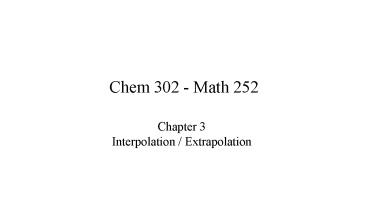Chem 302 Math 252 - PowerPoint PPT Presentation
1 / 38
Title:
Chem 302 Math 252
Description:
Need to know the dependent variable at a value of the independent variable that ... Point is within range of experimental data then ... Causes jagged plots ... – PowerPoint PPT presentation
Number of Views:40
Avg rating:3.0/5.0
Title: Chem 302 Math 252
1
Chem 302 - Math 252
- Chapter 3Interpolation / Extrapolation
2
Interpolation / Extrapolation
- Experimental data at discrete points
- Need to know the dependent variable at a value of
the independent variable that was not measured - Need to know what value of the independent
variable gives a particular value of the
dependent variable - Point is within range of experimental data then
called interpolation - Point is outside range of experimental data then
call extrapolation - Same techniques
- Extrapolation more risky
3
Linear Interpolation
- Assume data varies linearly between 2 points
- Connect-the-dots
4
Linear Interpolation Viscosity of Water
Find ? at 25 C
Exp ?25 8.937 mP
5
Linear Interpolation Viscosity of Water
ln(?) vs 1/T nearly linear
6
Linear Interpolation Viscosity of Water
7
Linear Interpolation Viscosity of Water
Find ? at 25 C
Exp ?25 8.937 mP
8
Linear Interpolation Heat Capacity of Benzene
Find C at 220, 250 270 K
Find C at 20 K
Exp C20 8.4 J/K
9
Quadratic Interpolation
- Assume data is quadratic between 3 points
10
Quadratic Interpolation
Do it !
11
Quadratic Interpolation
12
Quadratic Interpolation Viscosity of Water
Find ? at 25 C
Exp ?25 8.937 mP
13
Quadratic Interpolation Viscosity of Water
Find ? at 25 C
Using points 2,3,4
Using points 3,4,5
Exp ?25 8.937 mP
14
Quadratic Interpolation Heat Capacity of Benzene
Find C at 20, 220, 250 270 K
15
Lagrangian Interpolation
- Generalization of linear quadratic
interpolations - Uses nth order polynomial n1 points
Unique solution
16
Lagrangian Interpolation
17
Lagrangian Interpolation
18
Other Interpolation Functions
- Does not have to be a power series
- Methods are same as Lagrangian Interpolation
- Usually 2nd order (quadratic) or 3rd order
(cubic) Lagrangian interpolation is sufficient
19
Lorentzian Interpolation
- Uses Lorentzian lineshape
Peak height A Peak Position x0 Full Width at
Half Height (FWHH) 2/B 3 three points (usually
three at top of peak)
20
Lorentzian Interpolation
21
Lorentzian Interpolation
Quadratic interpolation on 1/y
22
Magnitude-Lorentzian Interpolation
- Uses square root of Lorentzian lineshape
Peak height A1/2 Peak Position x0 Full Width
at Half Height (FWHH) 3 three points (usually
three at top of peak)
23
Magnitude-Lorentzian Interpolation
Quadratic interpolation on 1/y
24
KCe Interpolation
- Based on Lorentzian Magnitude-Lorentzian
e 1 quadratic e -1 Lorentzian e -1/2
Magnitude-Lorentzian Optimized e for different
lineshapes (mostly used in FTICR-MS)
Keefe, Comisarow, App. Spectrosc. 44, 600 (1990)
25
Magnitude-Lorentzian Interpolation
Quadratic interpolation on y-e
26
Gaussian Interpolation
- Based on Gaussian lineshape
Peak height A Peak Position x0 Full Width at
Half Height (FWHH)
27
Gaussian Interpolation
Can be converted to form
Quadratic interpolation on lny
28
Find Peak Position Height
29
Find Peak Position Height
- Seven Highest points
- Use various interpolation functions to find peak
position and height - Determine interpolation function (top 3, 5 or 7
points) - Differentiate interpolation function and find
root (i.e. find location max) - position - Evaluate interpolation function at peak position
(height)
1034.6 0.73050 1035.1 0.75487 1035.5 0.76894 1036.
0 0.77183 1036.5 0.75979 1037.0 0.73585 1037.5 0.6
9860
30
Find Peak Position Height
Quadratic Interpolation
31
Find Peak Position Height
Comparison of Interpolation Methods
32
Spline Interpolation
- So far methods have used a moving window of
subset of data - May be discontinuous at edges of windows
- Causes jagged plots
- Spline interpolation forces slopes (and in some
cases higher derivatives) to match at edges of
windows - Creates smooth plots
33
Cubic Spline with Slope Matching
- Value of x such that x2 lt x lt x3
p(x) forced to pass through (x2,y2)
(x3,y3) p?(x) forced to match slopes at (x2,y2)
(x3,y3)
34
Cubic Spline with Slope Matching
Approximate slopes
35
Cubic Spline with Slope Matching
- Between 1st and last pair of points
- Can set slopes 0
- Natural spline
- Good if data is flat at extremes
- Can set
- Useful if slope is basically constant
- Can extrapolate using closest region
- Can set
36
(No Transcript)
37
(No Transcript)
38
(No Transcript)































